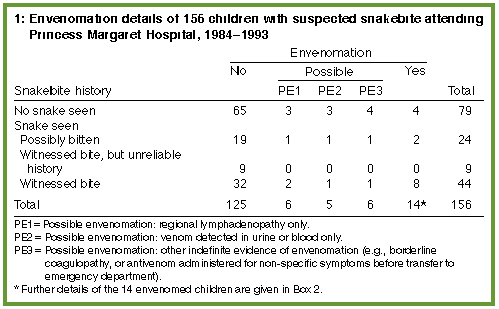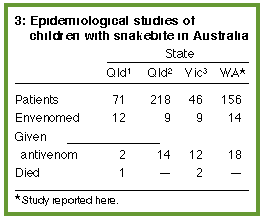Suspected snakebite in children: a study of 156 patients over 10 years
Helen J Mead and George A Jelinek
Readers may print a single copy for personal use. No further reproduction or distribution of the articles should proceed without the permission of the publisher. For permission, contact the Australasian Medical Publishing Company
Journalists are welcome to write news stories based on what they read here, but should acknowledge their source as "an article published on the Internet by The Medical Journal of Australia <http://www.mja.com.au/>".
Abstract - Introduction - Methods - Results - Discusssion - References - Authors' details
- - ©MJA1997
Abstract |
Objective: To describe the epidemiology and
clinical features of children presenting to an emergency department
with suspected snakebite. Design: A retrospective study of patient records. Setting: An emergency department of a children's teaching hospital (Princess Margaret Hospital) in Perth, Western Australia. Participants: All children attending the emergency department from 1984 to 1993 with suspected snakebite. Main outcome measure: Clinical and laboratory evidence of envenomation. Results: Over the decade studied, 156 children (mean age, six years and eight months) presented with suspected snakebite; over two-thirds (68%) were boys. In at least 31% of cases, no appropriate first aid had been applied. Only 14 children were envenomed according to clinical and laboratory criteria: 10 of these had coagulopathy; one of the 10 also had rhabdomyolysis. A Venom Detection Kit was used in 117 children. The test gave a positive result in 21 children (13%). Antivenom was given to 18 children, 14 of whom were definitely envenomed. Four of the envenomed children returned a negative result of Venom Detection Kit testing at all sites tested, and in five patients not clinically envenomed the urine specimen tested positive with the Venom Detection Kit (presumably a false positive result or subclinical envenomation). Of the 156 children, 130 were admitted to hospital, and 26 were discharged directly from the emergency department. All children recovered completely. Conclusions: (i) Many children did not receive appropriate first aid for snakebite; (ii) Most children with suspected snakebite presenting to the emergency department were not envenomed; (iii) Envenomation was best diagnosed by clinical features and laboratory investigations, with the Venom Detection Kit being used to determine the appropriate antivenom; (iv) Discharging children directly from the emergency department is not recommended. |
Introduction |
Three major Australian studies of snakebite in children have been
published.1-3 Two were from
south-east Queensland1,2
and the third from Victoria.3
No similar studies have been reported from Western Australia, but one
has been published on patterns of envenomation in 193 adults admitted
to Perth teaching hospitals.4
There are also no published data on children presenting to
Australian emergency departments with snakebite.
Our aim was to describe the presenting features, treatment and outcome in children with suspected snakebite attending an emergency department. We also examined aspects of the use of the Venom Detection Kit, which was widely used as an adjunct in the diagnosis and management of these children. |
Methods |
We studied the records of all children presenting to Perth's Princess
Margaret Hospital for Children with suspected or definite snakebite
between 1 January 1984 and 31 December 1993. If parents or other carers
had a reasonable suspicion that a child may have been bitten by a snake,
this was classified as "suspected snakebite", and in "definite
snakebite" a reliable history was available of a snake striking the
child (whether or not envenomation occurred), or there was clinical
and/or laboratory evidence of envenomation in circumstances
consistent with snakebite.
To ensure all records were found, multiple data sources were accessed, including hospital morbidity coding for inpatient admissions; intensive care unit records; and emergency department records. Data extracted from the records were entered onto a Microsoft Access 2.0 database to assist with analysis.5 To facilitate a comparison with the study in adults from Perth hospitals,4 data on patients' snakebite history and envenomation status were extracted and patients were grouped in the categories listed in the Perth study4 and shown in Box 1. Systemic envenomation was deemed present if there was clinical (vomiting, abdominal pain, or neurotoxic effects -- ptosis, convulsions, or difficulty with breathing or swallowing) or laboratory evidence (coagulopathy, haemolysis, rhabdomyolysis or renal failure). |
Results |
Over the 10 years, 160 children presented to the Emergency Department
at Princess Margaret Hospital with suspected snakebite. Patient
records were available for 156 children. The snake was brought in with
the patient for identification on 16 occasions (on one occasion the
snake was still alive!). Thirty-one children were admitted to the
Intensive Care Unit, 87 to a general ward, 12 to the Emergency
Department observation ward and 26 were discharged directly from the
Emergency Department.
Age and sex distribution
Location
Seasonal distribution
Bite site
First aid
Envenomation
Venom detection
The venom type detected by the Venom Detection Kit in envenomed patients is shown in Box 2. Use of antivenom
Case A: An eight-year-old boy with a witnessed bite received antivenom for regional lymphaden o pathy and headache. No venom was detected at the bite site, nor in blood or urine. Case B: A 10-year-old girl (no snake was seen) had a negative result of a Venom Detection Kit test of a bite site, and urine and coagulation studies showed no abnormality, but she was given antivenom because of symptoms of tiredness and non-specific weakness. Case C: A nine-month-old girl who was crying and vomiting and noted to have a mark on her arm was given polyvalent antivenom before transfer to Princess Margaret Hospital. No venom detection tests were undertaken. Her symptoms of fever and intermittent vomiting were subsequently thought to be due to a viral illness. Case D: A six-year-old girl had tiger snake venom detected at a possible bite site (but no venom detected in blood or urine). She was given tiger snake antivenom for symptoms of headache, fever, abdominal pain and nausea. A groin abscess was noted the next day, which may possibly have been the cause of her illness. Other supportive treatment
Outcome
|
Discusssion |
As in the previous epidemiological studies of snakebite in children
in Australia,1-3 most of the
children who presented to hospital with suspected snakebite were not
envenomed (Box 3). In our study the over-representation of toddlers
in the children presenting, despite an even age distribution of
children with envenomation, probably reflected heightened
parental concern and the difficulty obtaining a history from this age
group.
Patterns of envenomation and treatment for snakebite in Perth children were similar to those reported previously in adults.4 The sex distribution of victims, the seasonal pattern of envenomation and the site of bites were also similar. The venoms of the two snake genera responsible for most bites in Perth, Pseudonaja (brown snake) and Notechis (tiger snake), have powerful procoagulants, and coagulopathy was present in most (71%) of the envenomed patients. Among Perth snakes, only the tiger snake produces myolysis, and only one patient in this series had rhabdomyo lysis. Despite local differences in fauna, these findings are very similar to those in children with snakebite in Victoria.3 Despite continuing confirmation of the great efficacy of the pressure-immobilisation first aid technique in delaying venom spread,6,7 it is disturbing that this method is still not being used widely. In many cases it is also being applied incorrectly. More public education on first aid in snakebite is needed. The role of the Venom Detection Kit in patients with suspected snakebite attending emergency departments is discussed in Box 4. Although it appeared that no child came to harm after discharge from the Emergency Department, this practice is fraught with danger, as a case from 1973 illustrates. A two-year-old girl with restlessness and dry retching presented to hospital with an unclear history; the possibility of snakebite was raised by the parents. The examining medical officer concluded that she had been bitten by an insect, no investigations were ordered and she was discharged. The next morning she was found dead in bed, and it was later confirmed that tiger snake envenomation had been the cause of death. The Coroner found that there had been a lack of care on the part of the hospital, contributing to her death.10 In most children presenting to an emergency department there is no way of determining absolutely whether a venomous snakebite has occurred. There are special difficulties in obtaining a reliable history from young children and it may be tempting to use a negative result of a Venom Detection Kit to facilitate early discharge. Indeed, a number of children in this study were discharged from the Emergency Department without laboratory investigations, apart from use of the Venom Detection Kit. However, all children in whom snakebite is suspected, whether a snake was seen or not, should be admitted to hospital for observation and investigation (including coagulation profiles). In a number of cases of envenomation in our series, no snake bite was observed, and in two cases no snake was seen. Discharging children with suspected snakebite directly from emergency departments without a period of observation is not recommended. |
References |
(Received 6 Jul, accepted 20 Dec 1995) |
Authors' details
Department of Emergency Medicine, Fremantle Hospital, Fremantle, WA.Helen J Mead, FRACP, FACEM, Staff Specialist; formerly, Senior Registrar, Intensive Care Unit, Princess Margaret Hospital for Children, Perth, WA;
George A Jelinek, MD, FACEM, Assistant Director and Staff Specialist.
No reprints will be available. Correspondence: Dr George A Jelinek, Department of Emergency Medicine, Fremantle Hospital, PO Box 480, Fremantle, WA 6160.
©MJA 1997
<URL: http://www.mja.com.au/>
© 1997 Medical Journal of Australia.
Received 21 January 2026, accepted 21 January 2026
- Helen J Mead
- George A Jelinek






